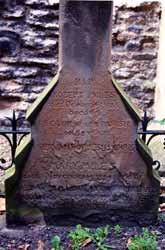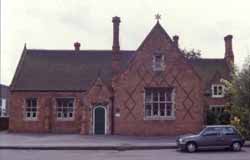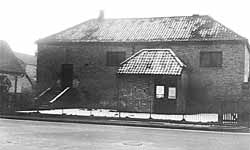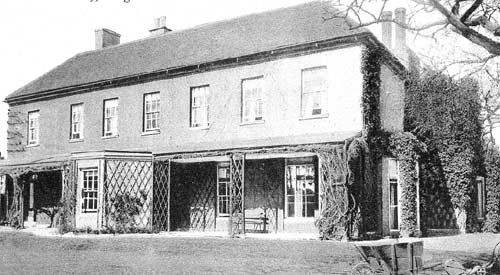![]()
HISTORY OF BINGHAM
BINGHAM THROUGH THE PARISH MAGAZINE 1868 to 1874
The parish magazines contain a wealth of information about Bingham in Church Notices, letters to the parishioners from the Reverend Miles, homilies, reports on the school and other institutions supported by the church, monthly weather reports and short articles on such as The Irish Church, “Our Basis for Agreement” and many others. From these it is possible to build up a picture of some aspects of life in Bingham as seen through the eyes of Reverend Miles. Mention is made in the magazines of items contributed by parishioners, usually referred to by their initials, but the main contributor as both author and editor was the Rector himself.
CHURCH MATTERS
Bingham parish church was in crisis at this time, not least because the Church Rates ceased to be compulsory in 1869 and the Rector, Robert Miles, had to find other ways of raising money for its upkeep. Among his costs were the Sexton’s salary of £17 a year, fees for the organ tuner, the choir and the organist and the debt on repairs to the organ. He set a weekly Offertory and raised £89 : 1 : 0¾ in 1869. Of this £28 : 10 : 10 was taken for the church. The rest went to Nottingham Hospital, Foreign Missions, the Organ debt, Hospital for Sick Children, the expenses of the Mission and for the “Sick and Needy”. The Offertory, being voluntary, did not produce what was needed and in April 1870 the Rector was asking the heads of families to make a regular contribution of 1d morning and evening. He calculated that this would give him £75 a year if all 200 families paid. In January 1873 the Rev Miles was prepared to admit in a letter to parishioners that the Church was in crisis everywhere.
Despite this Bingham St Mary’s and All Saints church played a prominent part in the community and the Reverend Miles was full of ideas and initiatives both for the benefit of the people and the church. Actions taken to focus the attention of the villagers on the church included forming a Society for the propagation of the Gospel in July 1969 and The Guild in January 1870. Some things he started for the community appeared to be short lived, but more information about them might be forthcoming if the magazines for 1871 and 1872 could be found.

The gravestone, now sadly
eroded, commemorates the lives of Reverend Robert Miles and his wife
Mary Ellen.
It rests beneath their memorial window in the churchyard.
Photo: Peter Allen
EDUCATION
In 1870 there were five schools in Bingham. He writes that there were 179 pupils at the Church School, 165 at the Infant School (also under the church), an estimated 165 at the Wesleyan School and 20 in each of the two private schools, Miss Strong’s and Miss Clifton’s. These figures have not been confirmed from other sources.
Annual reports, accounts and Inspector’s reports for the church schools are summarised in the parish magazines (click here to see one such summary). The schools were overseen by a committee of ten men, under the chairmanship of the Reverend Miles. There was also a Ladies Committee of four. Mr R. Lindsay was the Master in 1868, Mrs Hoe the Infant Mistress, Miss Jane Brown the Sewing Mistress and Fred Coy the Monitor. If later years are to go by there might have been two pupil teachers, but they were not mentioned. In 1874 two were named: Fred Coy, who had progressed from monitor to pupil teacher, and William Wall.

Church House was designed by Sir
George Gilbert Scott, one of the foremost “Gothic” architects
of the time. He also worked on the restoration of the church. Building
started in 1846. It is a classic for the era, with Tudor chimneys,
Elizabethan diamante patterned brickwork, neo-gothic arches and
patterned roof slates.
Photo: Peter Allen
The accounting year was changed in 1868, so the accounts for that year cover the period March to end December. They give a hint at the difficulties under which the school operated. Out of a total expenditure of £260 : 7 : 2 ½d for the nine-month period there was a debt of £140 : 8 : 5 ½d and it was reported that over the previous four years there had been an average excess of expenditure over income of £50. The Master was paid £53 : 15 : 0 for the nine months; the Sewing Mistress £10 : 15 : 0. Subscriptions were just over £29 and the Rector pleaded for subscribers to be more generous. It seems that in 1868 both girls and boys, but not infants, were taught in a mixed school, but in order to tackle the deficit in funds, the Mixed School was discontinued on 10th January 1870 and the girls removed to and amalgamated with the Infant School under the united management of Miss Gilman and Mrs Hoe. The accounts for 1873 and 1874 show that it worked, but no explanation was given of what cost savings were achieved by this new arrangement.
In the period 1868 to 1874 there were five masters at the school. Mr R. Lindsay was appointed during 1868. He left in 1872 and was replaced by Mr Theodore Johnson, who resigned in January 1874 for what he called “a good opening in business”. Mr Samuel Woodward replaced him, but was found to be an impostor, whose real name was William Cowlishaw. He appeared before the Nottingham Crown Court on a charge of obtaining money by false pretences, but was acquitted. During the period of the trial a temporary master, Mr Hanim served in the school until June 1874, when Mr Ledsome took over as the permanent master.
To what extent this continual change was the cause
or a reflection of the school’s performance during this period cannot
be said, but it did not appear to be good. The school underwent periodic
closures. Few details are given about them, but in December 1872 the school
was inspected in religious knowledge and the General Inspector commented:
“Considering the irregularity with which
the school has been opened the paper work is most promising.”
The annual report for 1872 contains the statement:
“The failure of the whole school in
Arithmetic was entirely owing to a misunderstanding as to the manner of
the examination.”
In the issue for July 1873 the report of the Bingham Local Board of Education
is published. The Church School presented 13 children for examination,
of whom six obtained certificates. The papers of Frederick Shimeld were
lost. The school was again inspected in January 1874. In the Inspector’s
report he says that though the work done by the school is not as satisfactory
as it should be, in some respects there is an improvement over last year.
The Inspector took this opportunity to forbid the practice of stocking-seaming
during sewing lessons. It seems that the girls were taking their work
to school.
Though it is not explicitly stated, there must have been a problem with attendance in this period because twice during 1874 the Rector exhorted his parishioners to take note of the Agricultural Children’s Act, which he said was to come into operation in January 1875. In it no farmer could employ a child unless the parents were able to provide a certificate of the child having attended school during the past year 250 times if under 10 and 150 times if between 10 and 12. Farmers who ignored this new law were liable to a fine of up to five pounds and parents no more than one pound.
The Elementary Education Act, 1870, was to revolutionise
schooling in England and Wales by providing a national system of primary
education. Local Education Boards were established to set up and oversee
Board schools, which were independent of the churches. Religious education
in the Board schools, if provided, had to be non-denominational. The Reverend
Miles objected strongly to what he regarded as the provision in the Act
that allowed parents to remove their children from religious instruction.
In Bingham, the Wesleyan School, not the Church School, became the Board
school. In a letter to the congregation in January 1873 the Rev Miles
refers to this matter:
“Owing to the refusal of the School
Board to accept the terms offered by the managers of the Church School,
we have been obliged in self defence to open our schools under the old
system; the Wesleyan School henceforth ceases to be Wesleyan; ie to give
any definite religious instruction, and is simply the Board School for
secular teaching; our school is as it was.”
It seems from this that the Rector acted upon his
principles and set conditions for the conversion of the church schools
to Board Schools that retained religious instruction as it was. As a consequence
of losing out to the Wesleyans he had to send the hat around for subscriptions
to keep his own school going. It “reopened” (no information
about it closing) under new management on 24th June 1872. In the annual
report for that year the Rector wrote:
“The Committee wishes to thank all those
who, when matters came to a crisis last year (1872), subscribed so liberally
to maintain a definite Religious Education for the children of the parish.”
Despite the difficulties being experienced with the church schools, the Reverend Miles did not ignore other educational matters. In October 1870 he started a night school in the Boy’s School Room on Tuesday, Thursday and Friday evenings at 7 o’clock “for those men and boys who cannot attend day school because of work.” He also started Sunday School for children under six in September 1870, so that their parents could attend church.
LIBRARY AND READING ROOMS
In the magazine for January 1869 the
following appeared:
“A Reading Room, with 5 or 6 Daily and
Weekly Papers, Periodicals etc, with the privilege of using the Library
Books, has been commenced at the Infants’ School Room. The Room
is open daily from 12.30 to 1.30, and on Monday, Thursday and Friday Evenings,
from 7 to 10. The Subscription is 3d per week. The number of subscribers
at present is 30. The affairs are managed by a Committee. Rev R. Miles,
President.”
Four years later, in a letter to the
parishioners in January 1873, the Rev. Miles announced that:
“During the year we have established
a capital Reading Room and place of quiet amusement for the town.”
It is difficult to reconcile these two
statements, but in October 1874 there is an announcement that
a Parochial Club Room is to be opened for the young men of
the parish, subscription one shilling a month, payable in
advance:
“An attempt was made on a small scale
during the two last winters, and a small Reading Room opened with games
etc, this proved so popular, that it soon became inconveniently crowded,
and noisy. It has been resolved therefore to try and start the Club on
a better footing, in the large room, in Market Street: this room can be
divided by a curtain or a partition; in one half of the room games, cards,
bagatelle etc can be played, the other half of the room being reserved
exclusively for reading and writing. Smoking will of course will be permitted.”
While it is likely that the Parochial Club Room is a successor to the “capital Reading Room” opened in 1872, the fate of the one opened in January 1869 is not described in any of the magazines available.
There is a similar state of confusion about the library. It is assumed that the library referred to in 1869 is in the Infants’ School, but in January 1873 a set of rules was published for a “new” lending library in the Rectory. This was managed by the Guild with four ladies, Mrs Pacey, Miss Smith, Miss Miles and Miss Drinkwater forming the committee. A subscription of two shillings a year allowed subscribers to take out one book at a time; four shillings allowed them two books and the first reading of all new books and periodicals. The library was to be opened between three and four every Monday and was to provide, “a few sound theological books, Church tales and periodicals, and novels of a good tone.” By March there were 78 books (link to Library pop-up) in the library, 90 in July and a further 40 added by the end of 1873. Private subscriptions and grants from the S.P.C.K. (the Society for the Propagation of Christian Knowledge) and Trustees of Rebecca Hussey’s Book Charity were used to buy them, though some were donated. The library outgrew its premises and moved to the Infants’ School in Market Street in April 1874. [The Infants’ School is referred to as in Market Street in all the parish magazines, but it probable that it actually was what is now Long Acre Studio on Long Acre opposite the top of Market Street.]

Long acre Studio was built in 1840
as the church school. Money for it was raised by subscription and
the land it stands on was a gift from the Earl of Chesterfield.
It served as one of the two church schools until some time in the
1880s, but seemed to have been used for other purposes in the evenings
from at least the early 1870s. It was listed in White’s directory
as a reading room/coffee room in 1889. Since then it has been the
HQ for the Bingham town band, the drill room for the Imperial Yeomanry
of S. Notts Hussars, the British Legion, a cinema, a photographic
studio and is now an antique shop. This picture was taken in the
1970s.
Photo: Margaret Sibley
THE COAL CLUB
The parish magazines gave a report on the weather for each month and it seems that the winters then were much colder than now. There were many days of frost, snow or cold rain and mean temperatures for November to March were nearly always less than 38o F. A good supply of coal through the winter was essential and it came to Bingham through the Coal Club.
The Coal Club was a means of providing subsidized coal for the poor of the parish. Each year the club commenced in April and closed at the beginning of December. “Free Contributors”, such as the Earl of Chesterfield and the Rector himself made donations to the club. The poor paid in through the summer at an agreed rate for the year. The coal was purchased by contract from suppliers. During the summer of 1869 the set contribution from the poor was based on a price of eight shillings per ton to them; the price paid for the coal in the following winter was 10s 9d a ton, indicating that the coal was subsidized by the “Free Contributors by 2s 9d a ton. The eight shillings subscription remained stable until 1872, when it rose to 16 shillings a ton. The Trades Unions Act of 1871 had returned to trades unions many of the freedoms that had been removed in 1867. The pent-up grievances of four years erupted in many strikes and the coal owners would not agree a contract with Bingham. In the end the Coal Club had to purchase at 19 shillings a ton. Subscriptions from the rich were low and the Rev Miles reacted by saying that for the next year the Coal Club was going to exclude from membership anyone whose wages “seemed” too high. In 1873 coal was purchased at 23 shillings a ton and went to contributors at £1 a ton, but with a 10d rebate. The amount purchased that year from Mr Nicholson and Mr Baxter was only 93 tons, contrasting with 148 tons in 1871. This was said to reflect on the rapid decrease in the labouring classes in Bingham.
THE PENNY BANK
In the issue for February 1873 there is first mention of a Penny Bank. It reminded readers that this bank was open every Monday evening in the St Mary and All Saints’ School Room from 6 o’clock to 6.30 under the management of Mr Oakes and Mr T. Browne. Any sum may be paid in from a penny to five shillings. For sums under £10 and above 5 shillings at the close of each year 5% interest would be allowed. It was pointed out that in Cropwell Butler parish penny bank £1200 had been placed to the credit of subscribers during the last five years.
TEMPERANCE
In the magazine for November 1873 the Rev Miles issued an invitation to all parishioners to attend a Temperance meeting. He sought to define three orders of temperance in his long letter. These were, first, all temperate; second, all who would abstain from spirituous drink between meals, and third, total abstainers. He was rather keen on the second one. A meeting was held and though there was no vote taken the conclusion reached in the meeting was that a Temperance Society based on the Church Temperance Society rules would be a good thing for Bingham.
ENTERTAINMENT

The Rectory, built in 1764, was demolished in the 1960s to make way for the Robert Miles junior school. It was the place of birth of Robert Lowe, Chancellor of the Exchequer from 1868 to 1873, and the home of the rector, Canon Robert Miles, from 1845 to 1864. It was visited by Oscar Wilde and Lily Langtry, friends of his son, the artist Frank Miles. Photo by permission of Rose Whittaker.
The church was the centre for a lot of the village entertainment, with events often taking place in the Rectory grounds (photo above). Nearly all of them were contributory. A parish tea was advertised for January 1869 in the Boy’s School Room at 7pm, cost six (old) pence. There was an annual School Feast held in July on the Rectory lawn, at which school prizes were awarded. A very large public luncheon was held on 25th Sept 1873 to celebrate the reopening of the church after 27 years of restoration work. It cost 2/6 a ticket and was held in a marquee on the Rectory lawn. Mrs Briggs of the Chesterfield Arms provided the food. The Great Northern Railway issued return tickets for the price of a single at all stations between Grantham and Nottingham for the day. 270 attended.
An Amateur Dramatic Club was started in January 1873 and gave its first performances in the next month. The Rector was rather taken with this and commented that this was not a new venture for Bingham. The Free School kept by Miss Strong was supported by the proceeds of some amateur performances given early in the century. [In Adelaide Wortley’s A History of Bingham, she goes into some detail about the theatre in Bingham]
Penny Readings were advertised in January 1869, of what it was not said. They were only mentioned once. The next similar sort of event was held during the winter months on 1872/73, when twelve popular entertainments and what the Rector called lime-light lantern lectures were given. This seemed to have started in 1872 when the equipment was purchased. The lime-light lantern, gas apparatus and fittings cost £8 : 4 : 8. Slides were hired from Messrs Newton and Co of London, costing £6 : 1 : 5. Only two of the lecture titles were given. Both were delivered by Mr Godfrey and were “Homes without Hands” and “The French and Prussian War”. Some music and a reading followed each lecture. They started at 7pm. Chairs cost 6d; second seats 4d and back seats 2d. The takings for 1872/73 were £15 : 15 : 1.
